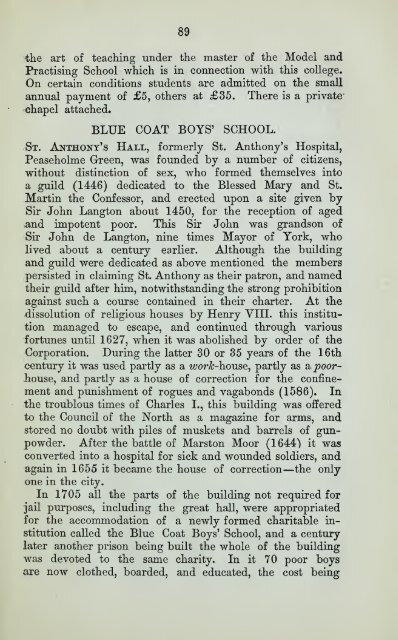practicalguideto00unse_0
Create successful ePaper yourself
Turn your PDF publications into a flip-book with our unique Google optimized e-Paper software.
89<br />
?tlie art of teaching under tlie master of the Model and<br />
Practising School which is in connection with this college.<br />
On certain conditions students are admitted on the small<br />
annual payment of £5, others at £35. There is a private*<br />
chapel attached.<br />
BLUE COAT BOYS' SCHOOL.<br />
-St. Anthony's Hall, formerly St. Anthony's Hospital,<br />
Peaseholme Green, was founded by a number of citizens,<br />
without distinction of sex, who formed themselves into<br />
a guild (1446) dedicated to the Blessed Mary and St.<br />
Martin the Confessor, and erected upon a site given by<br />
Sir John Langton about 1450, for the reception of aged<br />
,and impotent poor. This Sir John was grandson of<br />
Sir John de Langton, nine times Mayor of York, who<br />
lived about a century earlier. Although the building<br />
and guild were dedicated as above mentioned the members<br />
persisted in claiming St. Anthony as their patron, and named<br />
their guild after him, notwithstanding the strong prohibition<br />
against such a course contained in their charter. At the<br />
dissolution of religious houses by Henry VIII. this institution<br />
managed to escape, and continued through various<br />
fortunes until 1627, when it was abolished by order of the<br />
Corporation. During the latter 80 or 35 years of the 16th<br />
century it was used partly as a work-house^ partly as a poorhouse,<br />
and partly as a house of correction for the confinement<br />
and punishment of rogues and vagabonds (1586). In<br />
the troublous times of Charles L, this building was offered<br />
to the Council of the North as a magazine for arms, and<br />
stored no doubt with piles of muskets and barrels of gunj)owder.<br />
After the battle of Marston Moor (1644) it was<br />
converted into a hospital for sick and wounded soldiers, and<br />
again in 1655 it became the house of correction—the only<br />
one in the city.<br />
In 1705 all the parts of the building not required for<br />
jail purposes, including the great hall, were appropriated<br />
for the accommodation of a newly formed charitable institution<br />
called the Blue Coat Boys' School, and a century<br />
later another prison being built the whole of the building<br />
was devoted to the same charity. In it 70 poor boys<br />
are now clothed, boarded, and educated, the cost being















